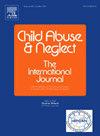School bullying among refugee and non-refugee adolescent students in Lebanon
IF 3.4
2区 心理学
Q1 FAMILY STUDIES
引用次数: 0
Abstract
Background
School bullying is a significant issue affecting adolescents globally. This study explores the prevalence and predictors of bullying among refugee and non-refugee adolescents in Lebanon, focusing on sociodemographic, protective, and risk factors.
Objective
To assess the prevalence and types of bullying and identify significant predictors, including sociodemographic variables, protective factors, and risk factors.
Participants and setting
A cross-sectional survey was conducted with 1906 adolescents aged 12–17 from 32 public schools in Lebanon.
Methods
Logistic regression analysis was used with sequential blocks to evaluate predictors of bullying: (a) sociodemographic variables (age, gender, refugee vs. non-refugee status); (b) protective factors (prosocial behavior, social-emotional assets, and school environment); (c) risk factors (emotional symptoms, conduct problems, hyperactivity/inattention, and peer relationship issues).
Results
The overall bullying rate was 56.3 %, with verbal bullying being the most common. Significant predictors included younger age (Odds Ratio [OR] = 1.35, p < 0.01), male gender (OR = 1.48, p < 0.01), and a negative school environment (OR = 1.62, p < 0.01). Syrian refugee students were more likely to be victims (OR = 2.03, p < 0.01), while Lebanese students were more frequently identified as perpetrators (OR = 1.78, p < 0.01). Protective factors were associated with lower bullying rates, whereas risk factors such as conduct problems and peer relationship difficulties were linked to higher bullying involvement.
Conclusions
The study reveals a high prevalence of bullying and underscores the need for comprehensive anti-bullying strategies. Addressing both protective and risk factors is crucial for creating a safer, more inclusive educational environment for all students.
黎巴嫩难民和非难民青少年学生中的校园欺凌行为
校园欺凌是影响全球青少年的一个重大问题。本研究探讨了黎巴嫩难民和非难民青少年中欺凌的患病率和预测因素,重点关注社会人口统计学、保护性和风险因素。目的评估欺凌的流行程度和类型,并确定重要的预测因素,包括社会人口统计学变量、保护因素和风险因素。研究人员对黎巴嫩32所公立学校的1906名12-17岁的青少年进行了横断面调查。方法采用logistic回归分析和顺序块来评估欺凌的预测因素:(a)社会人口变量(年龄、性别、难民与非难民状态);(b)保护因素(亲社会行为、社会情感资产和学校环境);(c)风险因素(情绪症状、行为问题、多动/注意力不集中以及同伴关系问题)。结果总体欺凌率为56.3%,以言语欺凌最为常见。显著的预测因素包括年龄更小(优势比[OR] = 1.35, p <;0.01),男性(OR = 1.48, p <;0.01),消极的学校环境(OR = 1.62, p <;0.01)。叙利亚难民学生更有可能成为受害者(OR = 2.03, p <;0.01),而黎巴嫩学生更常被认定为行凶者(OR = 1.78, p <;0.01)。保护性因素与较低的霸凌率有关,而行为问题和同伴关系困难等风险因素与较高的霸凌率有关。结论:该研究揭示了校园欺凌的高发性,强调了制定综合反欺凌策略的必要性。解决保护因素和风险因素对于为所有学生创造一个更安全、更具包容性的教育环境至关重要。
本文章由计算机程序翻译,如有差异,请以英文原文为准。
求助全文
约1分钟内获得全文
求助全文
来源期刊

Child Abuse & Neglect
Multiple-
CiteScore
7.40
自引率
10.40%
发文量
397
期刊介绍:
Official Publication of the International Society for Prevention of Child Abuse and Neglect. Child Abuse & Neglect The International Journal, provides an international, multidisciplinary forum on all aspects of child abuse and neglect, with special emphasis on prevention and treatment; the scope extends further to all those aspects of life which either favor or hinder child development. While contributions will primarily be from the fields of psychology, psychiatry, social work, medicine, nursing, law enforcement, legislature, education, and anthropology, the Journal encourages the concerned lay individual and child-oriented advocate organizations to contribute.
 求助内容:
求助内容: 应助结果提醒方式:
应助结果提醒方式:


